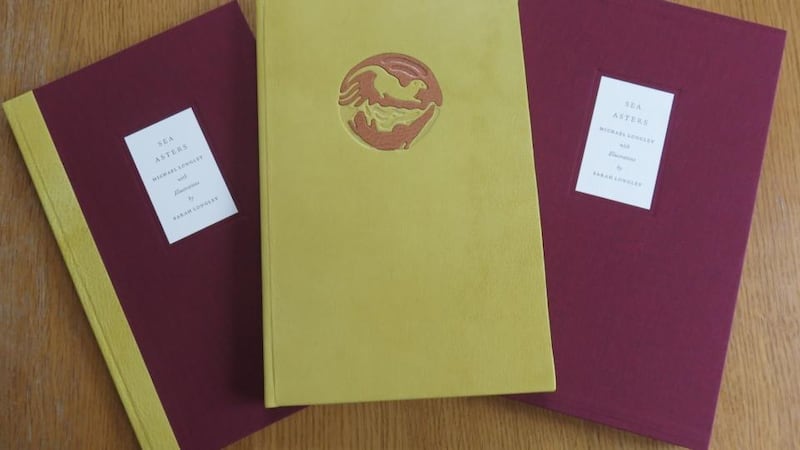The American author John Updike said: “A book is beautiful in its relation to the human eye, to the human hand, to the human brain and to the human spirit”, and it is this quote which encouraged me to get involved in Fine Press publishing.
I’d collected Updike’s books for a while, starting with the trade editions but moving to the limited editions produced by independent publishers. Some of these publishers had their own presses printing the books themselves. Others used specialist printers, choosing letterpress techniques that relied on hand-set type and sometimes incorporating commissioned images that responded to the author’s words. It was these editions that I’d liked best. One example was Updike’s In the Cemetery High Above Shillington. Published by a New Hampshire man, William B Ewert, the book combines Updike’s long poem with wood engravings by Barry Moser. Ewert also published, amongst others, Raymond Carver, Galway Kinnell and Seamus Heaney. I also had in mind editions of Ted Hughes’ work with illustrations by Leonard Baskin.
Turning 50, I decided that, as a hobby away from my rather mundane nine to five job, I wanted to do something similar. I’d also collected the work of British poet Simon Armitage. Simon had just worked on the Stanza Stones project with six poems on the theme of water being carved into rocks on the southern Pennines near where I live. I’d got to know Simon and suggested that I might do something with the poems. Remarkably, as I had no experience in publishing, he said yes. I then just needed to find out how to do it.

I was lucky to find a wonderful printer, John Grice at the Evergreen Press , nd John suggested Hilary Paynter would be an excellent choice to do wood engravings. Guided by John, Hilary and Patrick Roe at the Fine Book Bindery, the 183 copies of my first publication, In Memory of Water, entered the world. I then had to find some buyers for it. I contacted a small number of book dealers and tried to spread the word via social media and at Simon’s poetry readings. It went quite well. The book is beautiful and buyers were very complimentary about the way that Simon’s excellent poetry and Hilary’s marvellous engravings had been presented.
I was encouraged enough to do another book and Simon offered the opportunity to publish poems he’d written in response to stories from the first World War. My second publication, Considering the Poppy, with wood engravings by Chris Daunt, was published in October 2014 and sold out within five months. I was, of course, delighted but conscious that I needed to add other poets to what grander publishers might call their “stable”.
I'd read, and been intrigued by, a book, Love, Poet, Carpenter, in which authors wrote about Michael Longley. In addition, his very highly regarded collection The Stairwell had just been published by Jonathan Cape and I'd recently studied some of Michael's Homeric poems on a Poetry School course. These events prompted me to ask Michael if I might do something with him. Michael was immediately enthusiastic and, not too long afterwards, a dozen poems landed on my welcome mat. Michael had suggested that his daughter, the artist Sarah Longley, might illustrate the book. Sarah provided a dozen lovely pen and ink illustrations in response to Michael's poems. Of the 12 poems, three had appeared in The Stairwell but the others had not been previously published. My publication would be called Sea Asters.
I talked to John Grice about the format of the book: the page sizes, the layout, the quality of the paper and print font to be used. I talked to Patrick Roe about the cloths to be used for the binding and what leather to use for the spine of the standard and deluxe editions and for the fully leather bound “presentation” edition of the book.
In mid-May I picked the finished books up from the Fine Book Bindery in Northamptonshire and, the next day, drove north to Sarah’s home near the Kyle of Lochalsh where she and Michael signed the edition.
I believe that my three publications to date, utilising the considerable talents of excellent poets, printers, illustrators and book binders, have lived up to Updike’s assertion about the beauty of the book.
Michael Longley’s introduction to Sea Asters
Three poems from my last collection The Stairwell are included here with kind permission from my publishers Jonathan Cape (Two Otters, Amelia’s Poem, Birth-Bed.) The other nine poems are new. Several of them reflect my discovery of the landscape around Lochalsh in the western Highlands of Scotland, where my daughter, the artist Sarah Longley, now lives with her partner and two daughters.
Sarah's imagination and mine have been intertwined for many years. We are both drawn to remote places and the creatures and plants that live there: otters, badgers, stoats, raptors, waders, dragonflies. I introduced Sarah as a child to the machair-like dune-surrounded plain at Carrigskeewaun in Co Mayo (the duach); and, reciprocally, she has introduced me in my seventies to the Lochalsh salt marsh and its surrounding hills:
In your pictures, Sarah,
And my poems, the Irish
Otters of Carrigskeewaun
And the Scottish otters
Of Lochalsh keep in touch.
Sea Asters
I have got to know the fawn’s
Salt-marsh skeleton, abstract
Vertebrae and white ribs
In a puddle jellyfish fill
At spring tide, ghost circles
Close to the sea asters’
Purple golden-hearted
Scruffy loveliness.
The Snowdrops
Inauspicious between headstones
On Angel Hill, wintry love-
Tokens for Murdo, Alistair,
Duncan, home from the trenches,
Back in Balmacara and Kyle,
Cameronians, Gordon Highlanders
Clambering on hands and knees
Up the steep path to this graveyard
The snowdrops whiten, green-
Hemmed frost piercers, buttonhole
Or posy, Candlemas bells
For soldiers who come here on leave
And rest against rusting railings
Like out-of-breath pallbearers.






